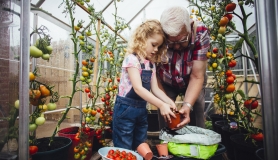I remember the discovery that many of the weeds that kept popping up in my garden actually had incredible and much needed medicinal uses. And the utter childlike joy that accompanied it! That bed of nettles was actually rich in minerals and an amazing tonic for restoring general health to the body as well as enriching the soil. Dandelion was an under-utilised spring green, delicious sautéed for lunch and also beneficial as a liver tonic. Plantain became the herb I reached out for to soothe pesky splinters and other sore skin complaints. I started to notice the self-heal plant that grew around the periphery of my lawn.
The chickweed that enjoyed sprawling over my vegetable beds in the polytunnel was now no longer thrown onto the compost heap but rather gathered into my garden trug and brought home to be blitzed into a delicious pesto or soaked in oil to make the perfect baby balm for my newborn.
My wild hedgerow not only protects me from the salty winds that batter the Atlantic coast here in County Antrim, Ireland, but also supplies me with a rich source of herbal medicines. It has been shown that the abundant, antioxidant-rich berries of the hawthorn and elder can indeed gently boost our health during those challenging winter months. The spring greens such as dandelion, cleavers and chickweed that grow in the shelter of the hedge provide a gentle detox to the body and a tonic when used in infused vinegars and teas. In summer, the abundance of blossom calls for heart medicine – flower essences to shift energy, blossoms tinctured and edible flowers made into the ultimate celebratory food.
Here we’re working with the pretty, apple scented chamomile, which has long been associated with sleep and as a nerve tonic. I’d say it’s one herb we should all grow! It’s time to start your own home apothecary.
And starting small is good. A home apothecary can be anything from a row of glass jars filled with dried herbs for teas to a cupboard of syrups, infusing tinctures, spiced vinegars and sweet herbal honeys.
CHAMAEMELUM NOBILE & MATRICARIA CHAMOMILLA
FAMILY: Asteracae
PARTS USED: Flowers
ENERGETICS: Cooling and drying
ACTIONS: Anti-inflammatory, antimicrobial, antispasmodic, bitter, carminative, nervine and vulnerary
SAFETY: Avoid use if allergic to members of the Asteracae family.
PLANT PROFILE
One of my first experiences of using herbs medicinally was with chamomile. A couple of dusty teabags lived at the back of our cupboard and would be pulled out as a last resort to induce sleep. I never really gave chamomile much more thought until I began to grow it myself from seed.
Freshly grown chamomile is a world apart from those old teabags! Verdant, fresh and with an apple-like scent, chamomile is one herb that we should all grow.
Pretty to look at with its daisy-like flowers, it takes little effort to grow chamomile and is fool-proof to look after once established. A summer’s worth of blossom, dried, can fill up quite a few jars and keep you going through the colder seasons.
IDENTIFICATION
Chamomile looks quite similar to a daisy. The white-petalled flowers have a bright yellow centre and sit on a long stem. The leaves are feathery in appearance and pinnate. There is another plant that’s similar to chamomile called pineapple weed (Matricaria discoidea). This is actually a chamomile too but is usually found growing in the wild. It has a protruding, domed, yellow centre and almost unnoticeable petals and feathery leaves. It grows close to the ground and loves pavements and well-worn, compacted areas. Pineapple weed smells similar to chamomile but with a beautiful pineapple edge and has similar relaxing properties.
USES
Chamomile is well known as a herb that has an affinity with sleep. As a nervine it works beautifully to calm anxiety and is a great herb to drink in a tea before bed – it works equally well for overexcited children as well as overworked and worn-out adults! Chamomile helps to relax the peripheral nerves as well as muscles, which has an overall calming effect on the entire body along with the mind. Try brewing a mug of Chamomile Moon Milk to experience the effects of this soporific and reassuring herb. To calm babies that are fussy due to teething, try saturating a fabric teether or muslin in cooled chamomile tea and freeze it for a natural remedy for sore gums.
Chamomile is also an excellent remedy for upset tummies. Its antispasmodic, anti-inflammatory and antimicrobial properties are all great at helping to soothe intestinal walls and ease gas and indigestion. A cup of strong chamomile tea can be sipped throughout the day to calm and hydrate the system. You could also combine a few drops of chamomile essential oil in a carrier oil of choice and massage onto the tummy for relief. For a cramping tummy, try a warm external compress using a strong chamomile tea.
Personally, one of my favourite ways to use chamomile is in skincare. With a family prone to dry skin, I use chamomile daily for its calming and anti-inflammatory properties. I use it on my young children to clear rashes and soothe sensitive skin. I love to make an infused oil from the dried flowers and use this as the base for many skincare products.
A bath combining soothing chamomile and oats in a base of nourishing cocoa butter is great for sore and parched skin.
Finally, chamomile is a lovely herb to reach for to ease stuffed-up sinuses and congestion, as the anti-catarrhal properties can help to release the build-up of mucus. Try the flowers steeped in a tea or use them in a steam inhalation by pouring boiling water into a basin and adding a handful of chamomile. Once the water is cool enough to be comfortable, lower your head over the basin (covered with a towel) and take deep breaths.
HARVESTING & PREPARATION
Chamomile flowers are ready for harvest in mid-summer. Harvest the flowers on a dry morning when they are open. Pick the heads off the flowers and arrange on a tray in a warm, dry place inside or, alternatively, use a food dehydrator set at around 37ºC.
CHAMOMILE MOON MILK
When the night rolls in and it is finally time to put my feet up and grab a book, I love nothing more than a cup of this calming and relaxing moon milk. The gentle ritual of warming the milk with these calming herbs and pouring it into my favourite ceramic mug is a beautiful reminder to my body that the day is complete. With its creamy flavour, this milk is grounding and settling for the nervous system and the combination of chamomile and lavender, two gentle but powerful nervines, helps to ease away any lingering worries and usher in a deep, restorative sleep.
YOU WILL NEED
- 1 mug of oat or whole milk
- 2 teaspoons dried or fresh chamomile flowers
- Pinch of dried or fresh lavender flowers
- 1 teaspoon local honey or maple syrup
- Tea strainer
METHOD
- Pour the milk into a small saucepan and sprinkle in the chamomile and lavender. Make sure you don’t add more than a pinch of lavender as it is a strong-tasting herb and can easily overwhelm the moon milk if too much is used.
- Gently warm the milk and herbs for around 5 minutes, making sure you don’t boil the milk.
- After 5 minutes strain the milk into your mug using a tea strainer. Sweeten with the honey or maple syrup.
CHAMOMILE & OAT BATH MELT
These bath melts are a complete luxury for itchy, sore skin or those who suffer from eczema. The chamomile flowers create a beautiful bath infusion that treats skin complaints while the oats are soothing and calming to the epidermis. Once made, the bath melts will last about six months in a dry, airtight container.
YOU WILL NEED
- 1 tablespoon rolled oats
- 1 tablespoon dried chamomile flowers
- 70g cocoa butter
- 1 /2 tablespoons chamomile and calendula-infused sunflower oil
- 10 drops lavender essential oil
- 8 drops mandarin essential oil
- Small silicon cupcake mould
- Double boiler or thick-bottomed saucepan
- Muslin
- Raffia twine
METHOD
- Combine the oats and chamomile flowers in a clean, dry bowl. Sprinkle into the silicon moulds, filling these until they are about half-full.
- Melt the cocoa butter in a double boiler or saucepan over a low heat. Once melted, add the infused sunflower oil and essential oils, and stir well. Pour the mixture into the filled moulds until you reach the top. Allow to cool overnight.
- Once the bath melts are completely hard, pop them out of the moulds, wrap each one in a small square of muslin and secure in place with some raffia twine.
TO USE
Place the bath melt in a warm bath and let it dissolve gradually to create a soothing, milky bath, fragrant with calming oils and herbs. The leftover herbs and oats in the cloth create a sort of bath teabag, infusing the water further with skin nourishing benefits.
ATIONS
You can adjust this recipe to make many variations. Try infusing the sunflower oil with rose and lavender instead, swap out the chamomile flowers for rose petals and omit the mandarin oil for a bath melt that will bring back memories of summer.
HOW TO MAKE AN INFUSED OIL
YOU WILL NEED
- Dried or wilted herb (chamomile and calendula for example),
- Carrier oil (such as sunflower)
- Clean, dry, wide-mouthed jar with lid, label,
- muslin and fine-mesh strainer, Storage bottle with lid
METHOD
- Roughly chop the dried or wilted herbs and place in the jar, filling it roughly half-full.
- Pour the carrier oil, filling the jar and making sure all the herbs are covered. Use a clean, dry chopstick to stir and release any air bubbles.
- Seal the jar with the lid and label, then let the oil infuse for 4 weeks, giving it a little shake every few days or so.
- When ready, place a strainer lined with a piece of muslin over a jug. Pour the oil into the lined strainer. If you are using dried herbs, squeeze the muslin tightly to ensure all the oil has been removed from the herbs. If using wilted herbs, let the oil drip through into the jug, but do not squeeze the cloth.
- Funnel the infused oil into a clean, dry bottle, seal with a lid and label.
Becky Cole is a mother, forager, home herbalist and gardener living on an ethical, award-winning farm in Northern Ireland. She came across natural living when she was diagnosed with an autoimmune condition and became burnt out with her city life. Since moving to the country, she has become an avid gardener who grows vegetables, herbs and edible flowers and runs popular foraging walks, home apothecary workshops and natural skincare classes.
RESOURCES
READ The Garden Apothecary: How to Transform Flowers, Weeds and Plants into Healing Remedies by Becky Cole (£16.99 Hardie Grant)
FIND Events including Becky’s herbalism courses and wild kids’ club at her farm in Ballycastle broughgammon.com/events







